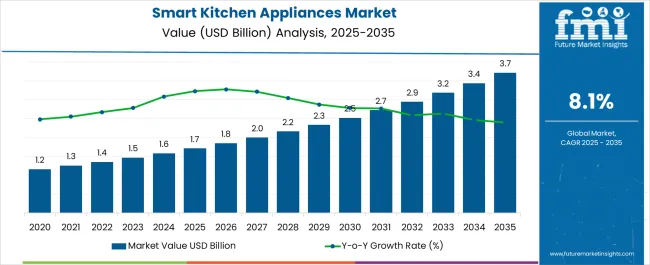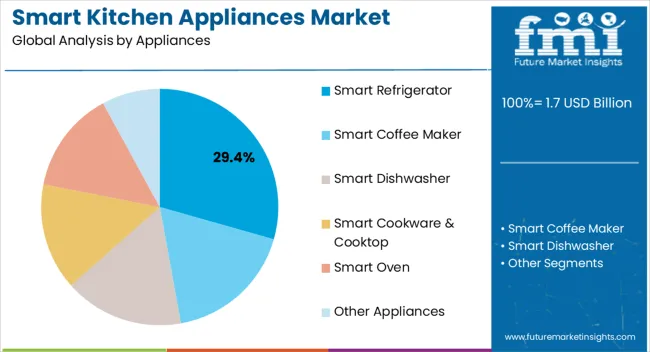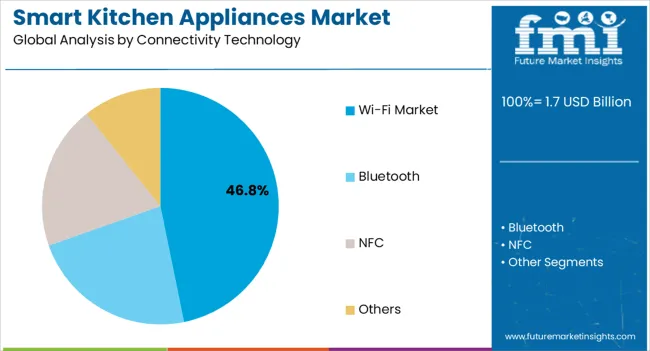The Smart Kitchen Appliances Market is estimated to be valued at USD 1.7 billion in 2025 and is projected to reach USD 3.7 billion by 2035, registering a compound annual growth rate (CAGR) of 8.1% over the forecast period.

| Metric | Value |
|---|---|
| Smart Kitchen Appliances Market Estimated Value in (2025 E) | USD 1.7 billion |
| Smart Kitchen Appliances Market Forecast Value in (2035 F) | USD 3.7 billion |
| Forecast CAGR (2025 to 2035) | 8.1% |
The smart kitchen appliances market is advancing steadily, propelled by the integration of digital technologies into household cooking and storage solutions. Rising consumer demand for convenience, energy efficiency, and connectivity has accelerated the adoption of smart-enabled appliances. Industry reports, press releases, and company disclosures have highlighted continuous innovations in artificial intelligence, voice assistants, and IoT platforms, which are reshaping how consumers interact with kitchen devices.
Increasing urbanization and the growing prevalence of connected homes have supported greater penetration of smart appliances across both developed and emerging markets. Additionally, heightened focus on sustainability has driven manufacturers to incorporate energy monitoring and food waste reduction features into product designs.
Strategic partnerships between appliance manufacturers and technology companies have further expanded product ecosystems, ensuring interoperability and seamless user experience. Looking forward, the market is expected to expand through advanced product launches, higher adoption of subscription-based services for device monitoring, and growing consumer awareness of the benefits of connected cooking and storage solutions.

The Smart Refrigerator segment is projected to hold 29.40% of the smart kitchen appliances market revenue in 2025, positioning itself as the largest appliance category. Growth of this segment has been fueled by rising consumer interest in food management solutions, energy efficiency, and integrated connectivity features. Company disclosures and industry journals have emphasized the role of smart refrigerators in monitoring food freshness, offering inventory tracking, and enabling automated grocery replenishment.
These features have aligned strongly with consumer lifestyles seeking convenience and reduced food waste. Additionally, the segment has benefited from increasing deployment of advanced sensors and AI-driven platforms that personalize recommendations for users.
Premiumization trends in household appliances have also supported adoption, with consumers willing to invest in higher-value products offering multifunctional benefits. As manufacturers continue to integrate cloud connectivity and expand compatibility with voice assistants and smart home hubs, the Smart Refrigerator segment is expected to sustain its market leadership.

The Wi-Fi segment is projected to contribute 46.80% of the smart kitchen appliances market revenue in 2025, establishing itself as the dominant connectivity technology. This segment’s leadership has been attributed to its widespread integration into households, reliable data transfer capabilities, and seamless compatibility with home networks. Industry sources and product announcements have noted that Wi-Fi connectivity allows users to control, monitor, and update kitchen appliances remotely through smartphones and smart assistants.
Wi-Fi-enabled appliances have offered manufacturers greater flexibility to deliver software updates, enhancing device functionality and extending product lifecycles. Consumer preference for wireless technologies that provide real-time notifications and integration with broader smart home ecosystems has further strengthened adoption.
Moreover, as internet penetration continues to rise globally, Wi-Fi remains the most accessible and cost-effective connectivity option for smart kitchens. With ongoing innovations in cloud platforms, security protocols, and AI-driven services, the Wi-Fi segment is expected to maintain its dominant role in powering the next generation of smart kitchen appliances.
The smart kitchen appliances industry recorded significant growth during the historical period. While cost remains a sticking point in the appeal of smart kitchen appliances, the severity of the issue could be reduced over the forecast period.
| Attributes | Details |
|---|---|
| Smart Kitchen Appliances Market Value in 2025 | USD 1,326.1 million |
More and more people are accessing disposable income, which could be spent on smart kitchen appliances. Smart kitchen appliance manufacturers are also making their products more affordable. Thus, the smart kitchen appliances market is expected to grow its consumer base during the forecast period.
For the forecast period, the smart kitchen appliances market is projected to grow at a significant rate of 8.5%. With consumers increasingly striving to ease their lives, smart kitchen appliances potentially have a big role. There is expected to be an increasing adaptation of smart kitchen appliances as people look to make trips to the kitchen more convenient.
Smart microwaves that send reminders to smartphones and smart refrigerators that keep a list of the food remaining in them are examples of smart kitchen appliances that increase convenience in kitchens. The smart kitchen appliances market is expected to benefit in the forecast period because these products make consumers' lives more comfortable.
Smart kitchen appliances rely on technology. The innovations in technology are expected to raise the bar as we advance. The infusion of AI into smart kitchen appliances is just one innovation that has propelled the market. With technology continuing to advance in leaps and bounds, the progression of the smart kitchen appliances market is expected to be strong.
The smart kitchen appliances market can be divided into the following segments: appliances and connectivity technology. By looking at the segments, consumers can determine what they prefer in their smart kitchen appliances. Information is also gleaned about what the consumers want their smart kitchen appliances to do.
Smart refrigerators lead the appliances segment of the smart kitchen appliances market. In 2025, smart refrigerators accounted for 25.70% of appliance market share.
| Attributes | Details |
|---|---|
| Top Appliance | Smart refrigerators |
| Market Share in 2025 | 25.70% |
Smart refrigerators are becoming increasingly common in households. Due to constant innovations, smart refrigerators are getting smarter and smarter. With smart refrigerators, consumers can get to know what is inside the refrigerator without leaving their place with the help of an app. This and other advancements like modifying temperatures have ensured the demand for smart refrigerators remains high.
While smart refrigerators enjoy the highest share of the market, other appliances are predicted to show growth, too. Smart coffee makers and smart dishwashers are expected to grow strongly during the forecast period.
The rising importance of the internet has led to an increasing reliance on Wi-Fi. Customers are partial to having Wi-Fi connectivity even in their kitchen appliances. This has led to Wi-Fi-enabled smart kitchen appliances having a massive market share in the connectivity technology segment. Smart kitchen appliances with Wi-Fi connectivity accounted for 20.40% of the market in 2025.
| Attributes | Details |
|---|---|
| Top Connectivity Technology | Wi-Fi |
| Market Share in 2025 | 20.40% |
During earlier periods, smart kitchen appliances with Bluetooth technology were in vogue. However, the internet, and consequently Wi-Fi, have become necessary commodities in people's daily lives. As a result, Wi-Fi-enabled smart kitchen appliances have taken over from Bluetooth-enabled smart kitchen appliances.
North America and Europe are the beneficiaries of leading technologies. Thus, the technology-driven smart kitchen appliances market enjoys significant market share in the two regions. North America is especially fertile ground for the smart kitchen appliances market, with the United States having a mammoth market share.
Asia Pacific is also a rapidly growing market. Japan and China are forecasted to have significant growth in the coming years, contributing to the smart kitchen appliances growth in the Asia Pacific. Another region tipped to experience notable growth is the Middle East and Africa (MEA).
| Countries | Market Share in 2025 |
|---|---|
| United States | 23% |
| United Kingdom | 7.4% |
| Germany | 6.2% |
| Japan | 4.8% |
| China | 6.2% |
The United States reigns supreme in terms of share in the smart kitchen appliances market. In 2025, the country accounted for a staggering 23% of the market.
Over the forecast period, the smart kitchen appliances market is projected to reach new heights in the country. Several factors contribute to making the United States such a lucrative market for smart kitchen appliances.
The abundance of top-notch hotels as well as houses is conducive to the growth of the smart kitchen appliances market. The market is also aided by government schemes that promote smarter living.
The high demand for smart kitchen appliances in the United Kingdom is a prime example of a revolution in smart appliances. The United Kingdom accounted for 7.4% of the smart kitchen appliances market share in 2025.
The acceptance of smart kitchen appliances in people's homes is a leading growth factor in the United Kingdom. The hospitality sector, too, is embracing smart kitchen appliances, further aiding the market.
Germany is another lucrative European country for the smart kitchen appliances market. In 2025, Germany accounted for a 6.2% share of the smart kitchen appliances market.
Germany is at the forefront of technological developments in Europe. There has also been an increase in the standard of living in Germany. These and other factors are expected to fuel the growth of Germany's smart kitchen appliances market.
Asia Pacific is a region with great potential for the smart kitchen appliances market. Japan is one of the leaders in this region. In 2025, Japan accounted for a 4.8% share of the global smart kitchen appliances market.
The ever-expanding economy of Japan is a significant contributing factor to the growth of the smart kitchen appliances market. The growing economy leads to development in the residential sectors, which in turn leads to more homes with smart requirements. Thus, the smart kitchen appliances market is propelled in Japan.
China is another region in the Asia Pacific where the smart kitchen appliances market is expected to grow at a rapid pace. In 2025, China accounted for 6.2% of the global smart kitchen appliances market share.
The intermingling of international brands and local manufacturers has left consumers with a variety of options in China. With the Chinese people’s lifestyle improving due to disposable income, the smart kitchen appliances market is enjoying notable growth in the country.

With technology essential to smart kitchen appliances, manufacturers are investing heavily to improve it. Significant money is going towards Research and Development (R&D) to come up with innovations. Smart kitchen appliance manufacturers are looking to get ahead of the competition through this strategy.
The market is fragmented, though several established players exist. There are opportunities for new entrants, and competition can be provided to the established manufacturers.
Recent Developments in the Smart Kitchen Appliances Market
Key Companies in the Smart Kitchen Appliances Market
The global smart kitchen appliances market is estimated to be valued at USD 1.7 billion in 2025.
The market size for the smart kitchen appliances market is projected to reach USD 3.7 billion by 2035.
The smart kitchen appliances market is expected to grow at a 8.1% CAGR between 2025 and 2035.
The key product types in smart kitchen appliances market are smart refrigerator, smart coffee maker, smart dishwasher, smart cookware & cooktop, smart oven and other appliances.
In terms of connectivity technology, Wi-Fi market segment to command 46.8% share in the smart kitchen appliances market in 2025.






Full Research Suite comprises of:
Market outlook & trends analysis
Interviews & case studies
Strategic recommendations
Vendor profiles & capabilities analysis
5-year forecasts
8 regions and 60+ country-level data splits
Market segment data splits
12 months of continuous data updates
DELIVERED AS:
PDF EXCEL ONLINE
Smart Vision Processing Chips Market Size and Share Forecast Outlook 2025 to 2035
Smart Touch Screen Scale Market Size and Share Forecast Outlook 2025 to 2035
Smart Magnetic Drive Conveyor System Market Size and Share Forecast Outlook 2025 to 2035
Smart Wheelchair market Size and Share Forecast Outlook 2025 to 2035
Smart Mining Technologies Market Size and Share Forecast Outlook 2025 to 2035
Smart Parking Market Size and Share Forecast Outlook 2025 to 2035
Smart Digital Valve Positioner Market Forecast and Outlook 2025 to 2035
Smart Card IC Market Size and Share Forecast Outlook 2025 to 2035
Smart-Tag Inlay Inserters Market Analysis - Size and Share Forecast Outlook 2025 to 2035
Smart TV Market Forecast and Outlook 2025 to 2035
Smart/AI Toy Market Size and Share Forecast Outlook 2025 to 2035
Smart Locks Market Size and Share Forecast Outlook 2025 to 2035
Smart Sprinkler Controller Market Size and Share Forecast Outlook 2025 to 2035
Smart Indoor Gardening System Market Size and Share Forecast Outlook 2025 to 2035
Smart Building Delivery Robot Market Size and Share Forecast Outlook 2025 to 2035
Smart Watch Market Size and Share Forecast Outlook 2025 to 2035
Smart Label Market Size and Share Forecast Outlook 2025 to 2035
Smart Mat Market Size and Share Forecast Outlook 2025 to 2035
Smart Water Management Market Size and Share Forecast Outlook 2025 to 2035
Smart Cold Therapy Machine Market Size and Share Forecast Outlook 2025 to 2035

Thank you!
You will receive an email from our Business Development Manager. Please be sure to check your SPAM/JUNK folder too.
Chat With
MaRIA